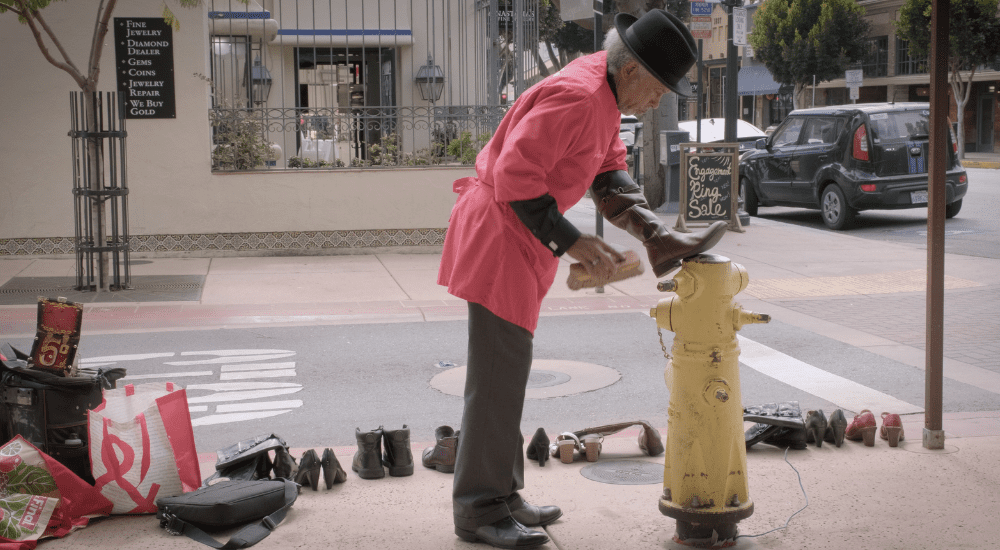Visit with a shoeshine caddie in San Luis Obispo
June 11, 2023

Editor’s Note: The following series, “Life in Radically Gentrifying Cayucos by the Sea,” to be posted biweekly includes the notes, thoughts, and opinions of an original American voice: author Dell Franklin.
Franklin’s memoir, “Life On The Mississippi, 1969,” is currently on Amazon.
By DELL FRANKLIN
My friend and neighbor, S. Harland (aka Hazel), a singer, musician and artist, told me, “There’s this shoeshine guy in San Luis Obispo. I think he’s homeless, but there’s a light about him, a light I can’t describe, and there’s a documentary about him at the Palm, and I thought you’d like to go.”
We caught the Sunday matinee. The doc was a close-up of a 61-year-old black man, who had unfortunately done prison time, enduring homelessness in San Luis Obispo with a pride and fortitude that enabled him to not only survive, but thrive, and become indeed a beacon of bright light among the homeless in an upscale downtown trending toward tony Montecito, down Santa Barbara way, where the Shoes Shine Caddie actually hails.
Adrian Spears is the man we’re talking about. As we watched the movie, Harland said, “Damn, he’s good looking, and he’s so articulate and thoughtful.”
“He also might be the most uniquely well-dressed man in San Luis Obispo,” I added. “Everything is perfectly pressed, and look at those cuffs and cuff links. And look at those shoes! Not only are they retro stylish, but they’re polished to a high gloss.”
The doc involved his life and life style—he was trying very, very hard, going through hoops, to adopt his 3-year-old daughter in a foster home down south, and secure Section 8 housing—of setting up his shoeshine business on the corner of Higuera and Garden streets, staying in apparently perfect physical condition jogging, maintaining his obvious splendid hygiene, and generally staying healthy while enduring the misery of sleeping in little tucked away areas off the street.
The doc showed how assiduously he dealt with these things, as well as following him into offices of officialdom where he continued to receive bad news on hooking up with his daughter (uncaring lawyer after lawyer quitting) and finding housing. He had good days and bad days, and toward the end one could sense the sadness at losing any chance of living with his daughter beginning to affect him, depress him, yet the light Harland described never dimmed.
He decided what was best for his daughter was where she was at—not an easy thing. And he also had visiting rights.
He made a decent living shining shoes, using first class shine products and brushes. One woman dropped off eleven pairs of shoes. Certain people volunteered to help him. And somebody had the humanity and generosity to make a film of his life. And eventually, at the end of the film, he finally secured a small apartment to keep him off the streets.
Harland was near tears when we stepped out of the theater. We decided to walk, and quickly happened onto the Gay Pride Festival taking place by the old Mission. We weren’t there two minutes when Harland pointed and said, “There’s the Shoe Shine Caddie!”
A few minutes later he was walking toward us, and quickly made notice of the best looking woman in the huge crowd, and within seconds we were all talking. Mr. Spears was rigged up in a suit and vest and hat and shoes and cuffs and cuff links giving off a Mardi Gras aura. Perfectly groomed, what you noticed were the eyes—pain and regret conquered by resolve and humility, softened with a large dose of kindness and humor.
Some people got it, and some don’t, and we never know where it comes from.
Since I was once involved in the shoe repair supply business which sold to shoemakers and shine boys down in South Central LA back in the day, I informed him I once had a shoeshine stand as a 13-year-old and asked him if he used saddle soap.
Immediately he hurried over to his supplies and came back with saddle soap.
“Nothing works without it,” I said.
He nodded. The three of us talked like old friends. People repeatedly came by to congratulate him on the film and everybody wished it would increase his business. I asked him about his mother, who had to be near 80, and was in the film.
“She’s doing just fine.”
“She is still a beautiful woman at her age,” Harland said.
“She must have been an absolute knock out in her youth,” I said.
Whereupon Adrian whipped out his cell phone and quickly showed us a photo of his mother as a young woman who resembled Lena Horne at her best.
It was also becoming obvious that the Shoe Shine Caddie, who had already established a positive identity in San Luis Obispo, was now becoming a full scale a celebrity.
The fact that the film was done so well, did not stoop to politics or explanation but just showed what this man’s life was like under such miserable circumstances, along with his ability to maintain a certain light and joyousness, made one think that this man, Adrian Spears, the Shoe Shine Caddie, just might be the happiest, most contented soul in one of the richest, most high-falutin towns in the country.






The comments below represent the opinion of the writer and do not represent the views or policies of CalCoastNews.com. Please address the Policies, events and arguments, not the person. Constructive debate is good; mockery, taunting, and name calling is not. Comment Guidelines